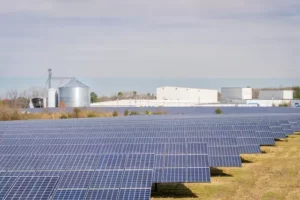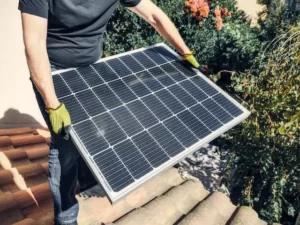In the realm of solar system maintenance, the question of whether to replace panels while keeping the inverter intact is a pivotal one.
While the allure of cost savings may initially sway decisions, the intricate interplay between panel and inverter efficiency warrants a closer examination.
Factors such as compatibility, age differentials, and technological advancements in panel-inverter synergy merit deliberation.
As we navigate the complexities of solar system optimization, unearthing the optimal balance between panel and inverter replacements is a journey rife with implications that extend far beyond mere equipment upgrades.
Key Takeaways
- Upgrading panels without changing the inverter is possible, but replacing the whole system is often more cost-effective.
- A new inverter with a new serial number makes you eligible for STC incentive payments.
- Replacing panels in complex systems may require assessing legacy equipment for compatibility.
- Safety compliance, environmental impact, and cost implications are crucial factors when considering solar panel replacements.
Factors to Consider Before Panel Replacement
Before embarking on the replacement of solar panels, it is imperative to carefully evaluate various factors to ensure a seamless transition and optimal system performance.
Panel compatibility is a critical aspect to consider when replacing solar panels without changing the inverter. Ensuring that the new panels are compatible with the existing inverter is essential to avoid efficiency losses or potential system malfunctions.
Additionally, assessing the inverter’s efficiency is crucial to guarantee that it can accommodate the new panels effectively. A mismatch between the inverter and panels can lead to decreased overall system performance.
Therefore, before proceeding with panel replacement, thorough compatibility checks and evaluations of inverter efficiency are necessary to achieve the best results from the upgraded system.
Benefits of Replacing Panels and Inverter
When considering the benefits of replacing both solar panels and the inverter, it is essential to acknowledge the significant improvements in system efficiency and safety that come with this comprehensive upgrade. By opting for a complete replacement, you can enjoy:
- Improved Efficiency: New panels and inverters often offer better performance and energy production.
- Enhanced Warranty Benefits: A complete system replacement typically comes with a comprehensive warranty, providing peace of mind.
- Increased Longevity: Upgrading both components ensures a longer lifespan for the entire system.
- Better Safety Features: New systems incorporate the latest safety standards, reducing risks associated with older equipment.
This holistic approach not only boosts efficiency but also ensures a safer and longer-lasting solar energy system.
Challenges in Upgrading Complex Systems
Upgrading complex solar energy systems poses intricate challenges that require careful consideration and strategic planning to ensure optimal performance and compatibility. Legacy compatibility issues often arise when integrating new components with existing systems, necessitating thorough assessments to ensure seamless operation. Technical upgrades, such as integrating advanced monitoring systems or optimizing energy storage solutions, can lead to compatibility issues within complex setups.
Assessing the interplay of various components and ensuring that legacy equipment can support newer technologies are crucial steps in upgrading complex solar systems. Professional installers can evaluate the current system, recommend suitable replacements, and address potential technical complications to enhance system efficiency and longevity.
Safety Precautions During Panel Upgrades
Assessing the safety implications of solar panel upgrades is paramount when enhancing system efficiency and longevity, particularly in complex setups where legacy compatibility issues can complicate the integration of new components. When undertaking panel upgrades, it is crucial to adhere to safety standards and employ proper installation techniques to ensure a secure and reliable system.
Here are key safety precautions to consider during panel upgrades:
- Compliance with Safety Standards: Ensure panels meet fire resistance requirements.
- Consideration of Fire Risk: Assess and mitigate fire hazards in the installation area.
- Grid Connection Approvals: Confirm that upgrades align with safety regulations for grid connection.
- Elimination of Fire Risks: Upgrading to new systems can eliminate fire risks associated with older components.
Environmental Impact of Panel Replacements
Enhancing the environmental sustainability of solar panel systems through replacement with newer, energy-efficient technologies is a crucial consideration for reducing the ecological impact of renewable energy installations. When replacing panels, energy efficiency plays a significant role in determining the environmental impact.
Newer panels are often more energy-efficient, which can lead to reduced overall energy consumption and lower greenhouse gas emissions. By upgrading to more efficient panels, the environmental sustainability of the system is improved, contributing to a greener energy footprint.
Considering the long-term benefits of energy efficiency and environmental sustainability is essential when deciding whether to replace panels in a solar energy system. It is important to prioritize these factors alongside other considerations such as cost and system performance.
Cost Analysis: Panel Replacement Vs. Whole System Upgrade
When considering the financial implications of replacing solar panels, a crucial analysis lies in comparing the costs associated with panel replacement versus opting for a complete system upgrade.
Cost Analysis Comparison:
- Panel Replacement:
- Initial cost is lower.
- May not improve overall system efficiency significantly.
- Potential compatibility issues with existing components.
- Limited warranty coverage on replaced panels.
- Whole System Upgrade:
- Higher initial investment.
- Enhances overall system efficiency.
- Ensures compatibility and optimization.
- Comprehensive warranty coverage for the entire system.
Careful consideration of the cost comparison and system efficiency improvements can guide the decision-making process towards the most cost-effective and beneficial option for your solar energy setup.
Expert Recommendations for Solar Upgrades
Implementing thorough performance evaluations is essential in guiding optimal decision-making for solar upgrades. Expert advice recommends considering maintenance tips such as:
- assessing the condition of the existing system,
- evaluating the compatibility of new components,
- ensuring safety compliance.
When upgrading solar panels, it is crucial to consult with experienced professionals who can provide tailored recommendations based on the specific requirements of the system. Maintenance tips also include:
- analyzing the environmental and cost implications of the upgrades,
- considering long-term benefits,
- exploring incentives that can help offset the total cost.
Frequently Asked Questions
Can I Upgrade My Panels Without Replacing the Inverter to Save Money?
Upgrading panels without inverter replacement may offer initial cost savings, but compatibility concerns and potential inefficiencies should be carefully evaluated. Consider warranty implications, system efficiency, and long-term benefits when deciding between partial or complete system upgrades.
What Are the Potential Risks of Not Replacing the Inverter When Upgrading Panels?
When upgrading panels without replacing the inverter, compatibility concerns may arise, affecting system performance and warranty implications. Incompatibility can lead to inefficiencies, void warranties, and potential safety hazards. A professional assessment is crucial for optimal system functionality.
How Do I Know if My Current Inverter Is Compatible With New Panels?
For a successful solar panel upgrade, ensure compatibility by conducting a thorough compatibility check between the existing inverter and new panels. Upgrading the inverter may improve efficiency and ensure panel compatibility, optimizing the system’s performance.
Are There Any Advantages to Replacing Both Panels and Inverter at the Same Time?
Replacing both panels and inverter simultaneously offers optimal system performance, potential compatibility benefits, and streamlined warranty coverage. Cost savings may arise from bundled installations. Assess compatibility, considering warranty implications, for a comprehensive upgrade yielding long-term benefits.
Will Upgrading Just the Panels Affect the Performance of My Solar System Significantly?
Upgrading just the panels can alter system performance due to mismatched components. Efficiency analysis and compatibility checks are crucial. Consider the cost implications of partial upgrades versus a complete system overhaul for optimized performance and longevity.
Conclusion
In conclusion, when considering the replacement of solar panels without necessitating an inverter replacement, it is essential to carefully evaluate various factors such as cost-effectiveness, system efficiency, safety precautions, and environmental impact.
While strategic panel replacements can be a viable solution for certain systems, expert recommendations lean towards weighing the benefits of a complete system overhaul, including enhanced warranty coverage and compliance with evolving standards.
Making informed decisions is crucial in optimizing solar energy systems for long-term sustainability and efficiency.



